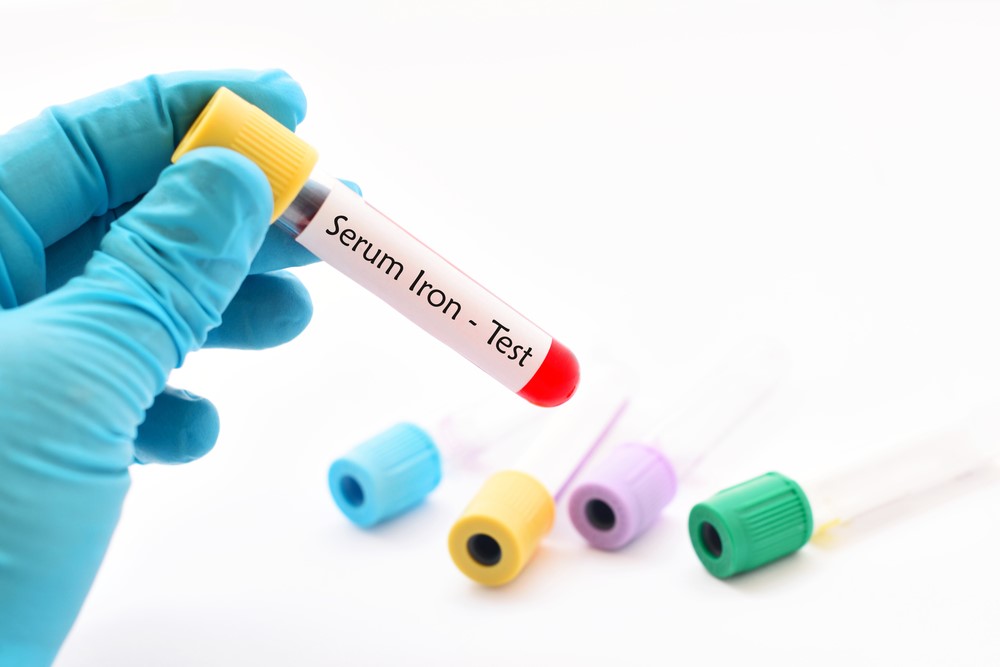
Transferrin: high, low, normal values, significance, treatment
Transferrin is the main iron transport protein in the blood; it is a glycoprotein synthesised mainly in the liver
Transferrin consists of a single polypeptide chain that has two binding sites for the ferric ion (Fe3+), while it has no affinity for the ferrous ion (Fe2+).
Normally in blood, 1/9 of all transferrin is saturated at both binding sites, 4/9 at one of the two sites and the remaining 4/9 have unsaturated sites.
Transferrin has a half-life of about 7 days, and its blood levels are regulated by iron availability, i.e. under iron-deficient conditions we have an increase in plasma transferrin concentrations while after iron administration it returns to normal levels.
Under normal conditions, transferrin is 50% saturated.
Functions of transferrin
After being synthesised by the liver and the monocytic-macrophage system, transferrin is stably – but reversibly – binds iron from the destruction of aged red blood cells and from the diet, absorbed in the intestine.
After binding, transferrin transports the iron in the body to its various sites of use, such as the bone marrow, and to its storage sites, such as the liver.
Why is it useful to know tranferrinemia?
Transferrinemia (i.e. the concentration of transferrin in the blood) is measured by a simple blood test and is a useful indicator of the body’s ability to transport iron.
This test is prescribed when iron metabolism abnormalities are suspected, but it can also be helpful in monitoring liver function and assessing an individual’s nutritional status.
In clinical practice, transferrin is generally assessed together with
- ferritinemia: the concentration of ferritin, the main protein involved in iron storage;
- sideremia: the proportion of circulating transferrin saturated with iron;
- total iron binding capacity (TIBC): an indirect measure of transferrin’s ability to bind iron.
Normal values
Normal values of transferrin in the blood are 200-360 mg/dL.
Causes of increased transferrin (hypertransferrinemia)
Blood transferrin levels increase in various conditions and diseases, including:
- during the use of the contraceptive pill;
- bleeding, including internal bleeding;
- sideropenic anaemias;
- in children during growth phases (especially between the ages of 2 and 10);
- hypoxaemic states;
- during pregnancy (third trimester);
- in cases of insufficient iron levels.
Causes of decreased transferrin (hypotransferrinemia)
Transferrin levels in the blood decrease in various conditions and diseases, including:
- liver disease;
- malnutrition;
- cachexia;
- protein deficiency;
- liver diseases such as cirrhosis, hepatitis, liver failure;
- renal diseases such as nephrotic syndrome;
- acute and chronic inflammatory states;
- haemochromatosis;
- repeated transfusions ;
- therapies with chloramphenicol or ACTH;
- chronic inflammatory diseases;
- tumours;
- iron or cortisone therapies.
A very severe absence of transferrin (below 10 mg/dL) is typical of a rare autosomal recessive disease called ‘atransferrinukaemia’.
Therapy
In the case of altered blood transferrin, treatment must be based on the underlying cause.
Iron-rich foods
Here is a list of various iron-rich foods (iron value expressed per 100 grams of product):
- Goose liver 30.53 mg
- Bitter dark chocolate 17.4 mg
- Clam 13.98 mg
- Bitter cocoa 13,86 mg
- Cooked oyster 11,99 mg
- Caviar 11,88 mg
- Canned chicken pate 9.19 mg
- Muesli with fruit and dried fruit 8.75 mg
- Muesli 8.20 mg
- Lentils 7.54 mg
- Oyster 6,66 mg
- Soya flour 6,37 mg
- Wheat germ 6,26 mg
- Chicken (leg) 6,25 mg
- Chickpeas 6,24 mg
- Boiled potatoes 6,07 mg
- Cuttlefish 6,02 mg
- Dried pine nuts 5,53 mg
- Cannellini beans 5,49 mg
- Fresh borlotti beans 5,00 mg
- Oat flakes 4,72 mg
- Hazelnuts 4,70 mg
- Anchovies in oil 4.63 mg
- Peanuts 4,58 mg
- Durum wheat 4,56 mg
- Dried almonds 4,51 mg
- Hazelnut and cocoa cream 4,38 mg
Read Also
Emergency Live Even More…Live: Download The New Free App Of Your Newspaper For IOS And Android
Iron Deficiency Anaemia: What Foods Are Recommended
Increased ESR: What Does An Increase In The Patient’s Erythrocyte Sedimentation Rate Tell Us?
Anaemia, Vitamin Deficiency Among Causes
Mediterranean Anaemia: Diagnosis With A Blood Test
Iron, Ferritin And Transferrin: Normal Values
Colour Changes In The Urine: When To Consult A Doctor
Why Are There Leukocytes In My Urine?
How Iron Deficiency Anemia (IDA) Is Treated
Thalassaemia Or Mediterranean Anaemia: What Is It?
Mediterranean Anaemia: Diagnosis With A Blood Test
Iron Deficiency Anaemia: What Foods Are Recommended
What Is Albumin And Why Is The Test Performed To Quantify Blood Albumin Values?
What Is Cholesterol And Why Is It Tested To Quantify The Level Of (Total) Cholesterol In The Blood?
Gestational Diabetes, What It Is And How To Deal With It
What Is Amylase And Why Is The Test Performed To Measure The Amount Of Amylase In The Blood?


